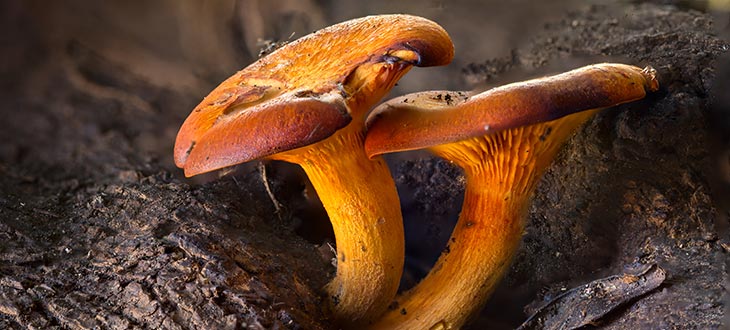Jack-o’-lantern Mushrooms Identification And Look-Alikes
Jack-o-lantern mushrooms are species of fungi with fruiting bodies that possess a unique feature – they can glow in the dark. Learn more about these mushrooms in this article.
Jack-o’-lantern is the common name of several species of mushrooms in the family Marasmiaceae, genus Omphalotus. Depending on the species, these mushrooms are typically found throughout Europe or North America.
These mushrooms have received the common name “jack-o’-lantern mushrooms” because of their orange color which resembles the skin of a Halloween pumpkin, as well as the fact that they can glow in the dark.
| Common Names | Jack-o’-lantern mushroom, Eastern jack-o’lantern, Western jack-o’-lantern |
| Family | Marasmiaceae |
| Genus | Omphalotus |
| Toxicity | Poisonous |
| Color | yellow to orange, orange-brown |
| Feeding Type | Saprobic (wood decomposers) |
| Growth Habit | Dense tufts or clusters on dead wood |
| Distribution | Europe, North America |
Three of the most well-known species of fungi of the Omphalotus genus, generally called “jack-o’-lanterns” include:
- Omphalotus olearius (jack-o’-lantern mushroom)
- Omphalotus illudens (Eastern jack-o’lantern mushroom)
- Omphalotus olivascens (Western jack-o’-lantern mushroom)
Contents
Distribution & Species
Omphalotus olearius are found throughout the woodland areas of Europe but have also been reported from the Western Cape Province, South Africa.
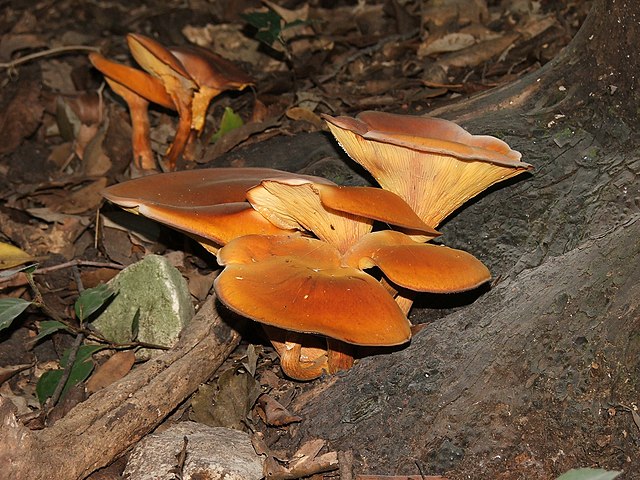
Omphalotus illudens which are known as the Eastern jack-o’-lanterns are widespread in Eastern North America.

Omphalotus olivascens (Western jack-o’-lanterns) are native to California and Mexico.
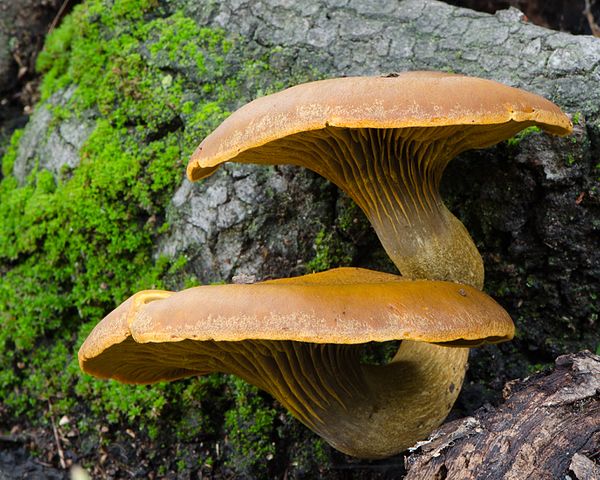
Jack-o’-lantern Mushroom Identification
Although several species of mushrooms in the genus Omphalotus are commonly referred to as “jack-o’-lanterns” and may have some slight differences, they also possess some common features that can help you recognize these fungi.
One thing you need to know is their growth habit.
The jack-o’-lantern is saprobic fungi. They usually grow in dense tufts or clumps on decaying stumps, on buried tree roots, or at the base of deciduous trees.
The shape of the cap and its color may vary slightly from one species to another.
Generally, the caps are initially convex with an inrolled margin, later flattening and developing upturned wavy margins.
The upper surface of the cap is smooth and can range in color from yellow to orange to orange-brown. On the underside, they have non-forking gills, having the same color as the cap. The gills are the only parts of the mushroom that can emit light in the dark.
The cap is supported by a yellowish-orange stem with a smooth surface, tapering towards the base.
Bioluminescence
As mentioned earlier, jack-o’-lantern mushrooms got this name due to the fact that they have an interesting quality that set them apart from many other mushroom species, bioluminescence.
Bioluminescence is the production and emission of light by living organisms. It occurs widely in marine vertebrates and invertebrates, as well as in some fungi, microorganisms, and fireflies.
Wikipedia
Do not imagine that this mushroom will light like a lantern. In fact, only its gills glow. They produce a faint green light in complete darkness when the mushroom is still young and in good shape.
Some sources state that this bioluminescence can even persist up to 48 hours after the mushrooms have been picked up.
This light is very hard to notice on most occasions. Thus, it is highly improbable to see these mushrooms illuminating the entire forest when you stumble upon them at night.
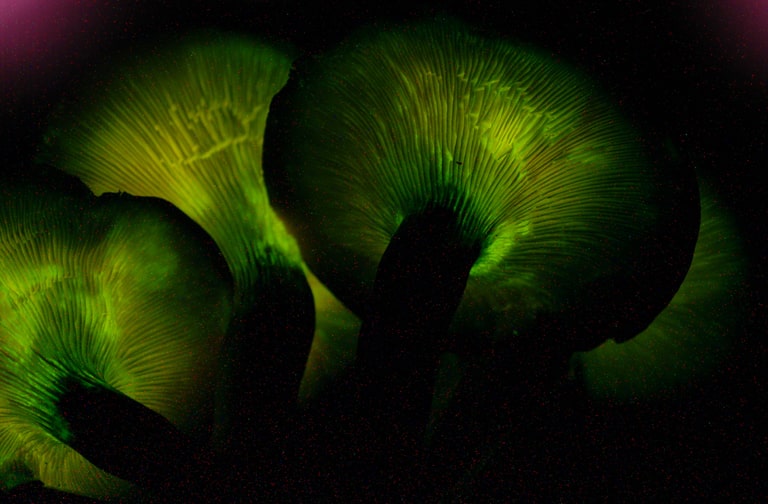
However, the jack o’lanterns are not the only luminescent fungi.
According to an article posted on the National Science Foundation about bioluminescent fungi, out of about 85,000 species of known fungi, only 65 species are known to possess this quality.
Although the role of bioluminescence in mushrooms is not yet fully known, many believe that this unusual characteristic serves mainly to attract insects during nighttime which helps with the dispersal of their spores.
Toxicity
All the jack-o’-lantern mushrooms are toxic and should not be ingested.
The toxin found in various species of Omphalotus mushrooms is called “illudin.”
Although jack-o’-lantern mushrooms are generally not considered lethal for a healthy adult, they can provoke severe adverse reactions if eaten. They are also more dangerous for young children.
Some of the most common symptoms associated with jack-o’-lantern mushroom poisoning include nausea, vomiting, severe abdominal cramps, diarrhea, weakness, and dizziness. (source)
Look-alikes
Jack-o’-lantern mushrooms (especially Omphalotus illudens) are oftentimes confused with golden chanterelles, which are some of the most popular wild edible mushrooms.
Golden chanterelles are most of the time mistaken for jack o’lanterns because of their golden-yellow color and relatively similar shape.
However, there are several differences between these two mushroom species.
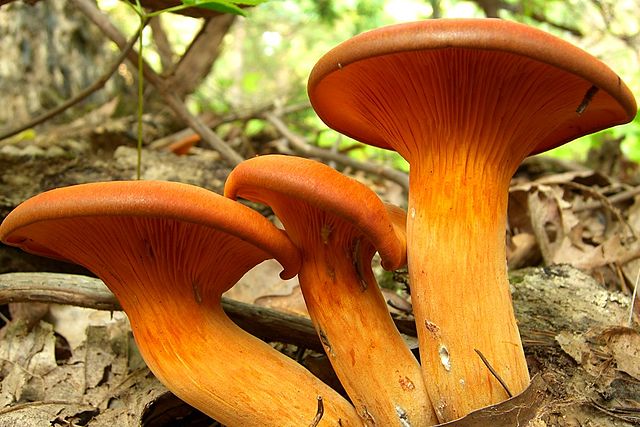

Chanterelles, unlike the jack-o’-lanterns, don’t feed on dead and decaying wood. They are mycorrhizal fungi and form a symbiotic relationship with the roots of living trees, helping them to extract nutrients and water from the ground. Thus, chanterelles grow many times further from the base of the tree trunks and do not grow on wood, but in the soil.
The caps of chanterelles are usually more funnel-shaped with wavy margins, while the ones of jack-o’-lanterns are typically more rounded.
Chanterelles have false gills that are in fact forked ridges that do not separate from the stem or cap. On the other hand, the jack o’lanterns have fleshy gills that can be separated fairly easily from the cap and stem.
Final Word
Although the jack o’lantern mushrooms are poisonous and should never be eaten or even touched, like many other saprobic species of mushrooms, they play an important role in the ecosystem. They feed on dead wood and decompose it into tiny particles that return to the ground as natural fertilizer, providing food for nearby plants.
These mushrooms are not only attractive due to their appearance but also because of their ability to sometimes emit a weak green light in complete darkness.

